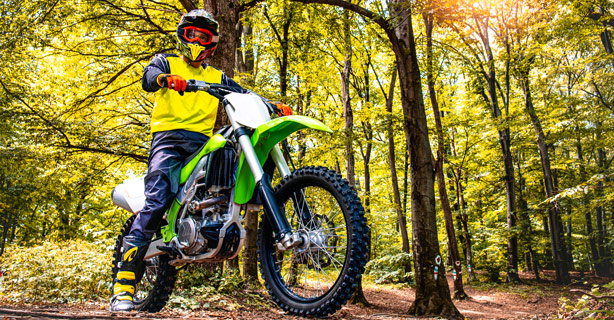Maintaining your dirt bike safety gear
Taking care of your gear helps it last longer and perform better. Here's a quick maintenance checklist:
Clean your gear after each ride
Regularly check for wear and tear
Store gear in a cool, dry place


0 min. read
Dirt-bike thrills and the risk of spills go hand in hand. But with the right gear, you can help minimize the impact of those unwelcome accidents.
We get it—you're here for the adrenaline rush, not a lecture. But trust us, proper gear can be the difference between brushing off a fall and ending your season early. Good safety equipment:
Reduces your injury risk
Boosts your confidence on tricky terrain
Helps keep you comfortable in dust, heat, or rain
Could save your life in a serious spill

When it comes to dirt bike safety, your helmet is the MVP. Wearing a helmet significantly reduces your risk of moderate or severe head injuries in crashes, and also lowers your risk of death.
Keep in mind, dirt bike and off-road helmets are constructed differently than motorcycle helmets. Make sure you invest in a helmet designed to protect you in an off-road scenario.
So, what should you look for in a dirt bike helmet?
Certification: DOT, ECE, or Snell certification ensures your helmet meets rigorous safety standards.
Fit: A well-fitting helmet should be snug but comfortable. No pressure points, no wobbling, and a comfortable balance.
Condition: If the helmet has been in an impact, or is more than five years old, replace it with a new one.
Ventilation: Good airflow keeps you cool and focused on the trail ahead.
Visor: An anti-fog visor is key for clear vision in all conditions.
Quality construction: Materials like fiberglass composites or polycarbonate offer top-notch protection without excess weight.
Comfort features: Removable, washable liners help keep your helmet fresh, ride after ride.

Dirt, dust, and debris are no joke when you're blazing trails. If your helmet doesn’t have a full visor, you’ll need additional eye protection.
Goggles shield your eyes from branches and materials kicked up by tires on rough terrain to help you see clearly. Opt for impact-resistant lenses with an anti-fog coating, and make sure they're compatible with your helmet.


Your feet and ankles are vital for controlling your bike, so they need serious protection. Here's what to look for:
Ankle support: Rigid ankle braces built into the boot help prevent twists and sprains during crashes or awkward landings.
Reinforced toe box: A sturdy toe area protects your feet from rocks, branches, and other trail debris.
Durable sole: Look for thick, rugged soles with aggressive tread patterns. These provide excellent grip on foot pegs and help you prevent punctures and maintain control when putting a foot down in slippery conditions.
Heat resistance: The inner side of the boot should have heat-resistant material to protect against burns from the engine and exhaust.
Adjustable closures: Multiple buckles or a combination of zippers and buckles allow for a custom, secure fit.
Waterproofing: While not all boots are fully waterproof, many offer some level of water resistance to keep your feet dry in wet conditions.
Flexibility: Despite their rigid protection, good dirt bike boots should allow enough flexibility for comfortable walking and bike control.
Shin protection: Extended protection up the shin shields against impacts and roost (debris kicked up by the rear wheel).

Protect your core with body armor that covers your chest, back, shoulders, elbows, and kidney areas. You can elect to wear individual pads that fit over your clothing—knee and shin pads, chest protectors, and elbow pads—or you can wear jackets, pants, or even underclothes with built-in armor.

Your hands are your connection to the bike. Keep them safe and comfy with gloves that provide:
Padded palms for reduced vibration
Knuckle protection
Breathable material
Good finger dexterity

Riding gear isn't just about looking cool—though that's a nice bonus. It should offer abrasion resistance, flexibility for easy movement, breathability, and reinforced areas in high-impact zones like your knees and seat.

When shopping for gear, keep these tips in mind:
Try before you buy (if possible)
Consider your riding style and terrain
Look for gear that's easy to clean and maintain
Don't compromise on quality to save a few bucks
Taking care of your gear helps it last longer and perform better. Here's a quick maintenance checklist:
Clean your gear after each ride
Regularly check for wear and tear
Store gear in a cool, dry place
At Dairyland®—a brand of the Sentry Insurance Group—we're all about keeping riders safe. And carrying dirt bike insurance is a great way to help protect your bike and your finances if you're involved in an accident. That way, you can focus on what really matters—the thrill of the ride. Let's keep the good times rolling, safely!
The general information in this blog is for informational or entertainment purposes only. View our blog disclaimer.